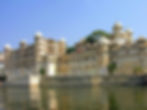

PLACES TO VISIT
Popularly known as the ‘City of Lakes’, Udaipur attracts people for its popular tourist destinations and is well-known for its history, culture, spectacular locales and Rajput-era palaces. Embark the deep-rooted symbolic history of the city when you visit the following attractions:
-
Lake Pichola
-
Fateh Sagar Lake
-
Doodh Talai Lake
-
Swaroopsagar
-
City Palace
-
Lake Palace
-
Monsoon Palace
-
Kumbhalgarh Fort
-
Shiv Niwas Palace
-
Bagore Ki Haveli.
-
Vintage Car Museum
-
Nathdwara
-
City Palace Complex
-
Ranakpur Jain Temple
-
Jagdish Temple
-
Saheliyo-ki-Bari
-
Pratap Smarak
-
Bhartiya Lok Kala Mandal
-
Shilpgram Fair
-
Gulab Bagh and the zoo.
-
Ropeway Karni Mata Temple


FATEH SAGAR LAKE
Lying to the north-west of Udaipur, Fateh Sagar Lake is a sparkling lake which is one of the major tourist spots in the city. Surrounded by the Aravalli Hills, it is the second largest artificial lake in the city and is known for its scenic beauty. The atmosphere here is calm, and tourists are bound to find themselves enthralled by the blanket of tranquillity the place warms them up with. One can witness the circumference of the Fateh Sagar Lake by driving on the Moti Magri Road and get a fantastic view of the entire lake. Apart from enjoying a laid-back afternoon in the serene beauty of this destination, you can also try your hand at boating and a number of other water sports that are available here for the visitors.
CITY PALACE, UDAIPUR
Built on the banks of Lake Pichola, the City Palace in Udaipur is considered to be the largest royal complex in Rajasthan. The magnificent palace was built in the year 1559 by Maharana Uday Singh and served as the main seat of power, where the Maharanas lived and administered the kingdom from. Subsequently, the palace was made even more splendid by his successors, who added a number of structures to it. The Palace now has an assortment of Mahals, courtyards, pavilions, corridors, terraces, rooms and hanging gardens. There is a museum here as well that showcases some of the finest elements of Rajput arts and culture - from colourful paintings to the typical architecture found in Rajasthani palaces.




LAKE PICHOLA
The Lake Pichola is an artificial lake located in the heart of Udaipur, Rajasthan. The oldest and one of the largest lakes of the city, the Lake Pichola observes lakhs of tourists because of its tranquillity and beauty. Flanked by lofty hills, heritage buildings and bathing ghats, it is a dream come true for peace and nature lovers. A visit to the Lake Pichola is incomplete without a boat ride, especially in the dawn. During evenings, it seems the entire place has been dipped in gold as you can see the heritage buildings and the pristine water turning golden with the sun's reflection. The enthralling views will take you to a different world of stillness and will also bring out your romantic side.
SAJJANGARH PALACE
Located just on the outskirts of the city of Udaipur, perched atop a hill, Sajjangarh Palace is a former royal residence belonging to the Mewar dynasty, who ruled over this place for centuries. The palatial complex is named after its patron, Maharana Sajjan Singh, who ordered its construction and had it erected in 1884. It was originally intended to be a nine-storeyed astronomical observatory to note and assess the arrival and patterns of monsoon clouds, which could be easily perceived from the palace because of its location at a strategic vantage point at one of the hilltops of Aravalli, called Bansdara Peak. For this reason, it has also earned the name Monsoon Palace. It would have also created employment opportunities for the subjects.




SHILP GRAM
Located near the Havala village, only 3 kilometres west on the outskirts of Udaipur, Shilpgram is a one-of-its-kind living ethnographic museum that reflects that same culture and heritage, not only of Rajasthan but of entire West Zone. Inaugurated by Rajiv Gandhi way back in 1989, Shilpgram is a collaborative effort dedicated towards upholding and promoting the lifestyle, art and culture born in the nooks and crannies of rural and suburban parts of western India. The main objective is to not only endorse the culture and way of living of ethnic minorities and tribal communities, but also keeping them alive for the next generations to know and appreciate.



